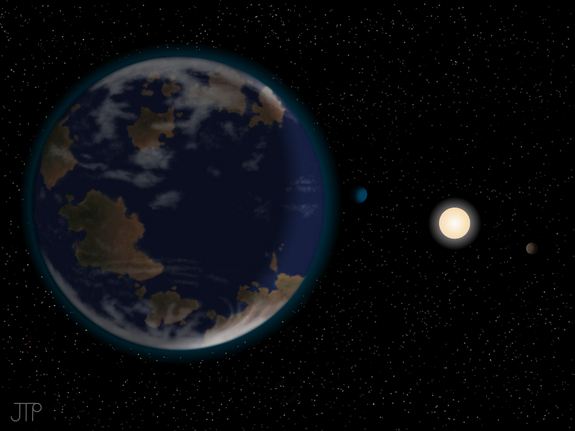November 8, 2012
The family of planets circling a relatively close dwarf star has grown to six, including a potential rocky world at least seven times more massive than Earth that is properly located for liquid water to exist on its surface, a condition believed to be necessary for life.

'Super-Earth' Alien Planet May Be Habitable for Life
November 8, 2012
The family of planets circling a relatively close dwarf star has grown to six, including a potential rocky world at least seven times more massive than Earth that is properly located for liquid water to exist on its surface, a condition believed to be necessary for life.

'Super-Earth' Alien Planet May Be Habitable for Life
Scientists added three new planets to three discovered in 2008 orbiting an orange star called HD 40307, which is roughly three-quarters as massive as the sun and located about 42 light-years away in the constellation Pictor.
Of particular interest is the outermost planet, which is believed to fly around its parent star over 320 days, a distance that places it within HD 40307's so-called "habitable zone."
The planet's five siblings are all believed to be too close to the star and therefore too hot for water to exist in a liquid state.
"The planetary system around HD 40307 has an architecture radically different from that of the solar system," lead researchers Mikko Tuomi, with the University of Hertfordshire in the United Kingdom, and Guillem Anglada-Escude, with Germany's University of Goettingen, write in a paper to be published in the journal Astronomy & Astrophysics.
The finding suggests there may be many ways for a planet to end up in a star's habitable zone, the astronomers added.
More detailed studies of HD 40307's brood are unlikely because the planets do not appear to transit, or pass in front of, their parent star, relative to Earth's line of sight.
The new findings are based on a re-analysis and refinement of data collected by Europe's High Accuracy Radial velocity Planet Searcher (HARPS) instrument, a light-splitting spectrograph installed on Europe's La Silla Observatory in Chile. Planets beyond the solar system can be detected by tiny gravitational tugs they exert of the light coming from their parent stars.
To find HD 40307's sixth planet, scientists had to make the difficult distinction between starlight impacted by a planet's gravity and the effects of stellar activity, such as flares and magnetic storms.
"All we know at this point is that it has a minimum mass of about 7.1 Earth-masses. We have no explicit follow-up planned, thought the HARPS team is probably still gathering more data, and may in the future be able to confirm these results, and perhaps add even more planets to the brood," astronomer Steven Vogt, with the University of California's Lick Observatory, wrote in an email to Discovery News.
"We feel pretty confortable that these six panets are all there," Vogt said.
Astronomers have no hard evidence that the sixth planet is a rocky world, however, but they point out that recent observations of hot super-Earths transiting bright nearby stars indicate a good fraction of the planets can be made of rock.
Whatever its composition, HD 40307's sixth planet would receive about 62 percent of the radiation that Earth gets from the sun.
"Even though the radiation is somewhat low compared to that received by the Earth, we note that the Earth lies actually reasonably close to the inner boundary of the sun's habitable zone," the scientists wrote.
The planet would be a prime target for space telescopes being designed that are sensitive enough to directly image relatively nearby Earth-sized worlds.
Courtesy: dicovery
















































































































